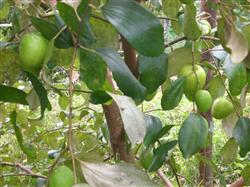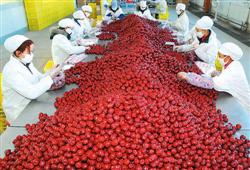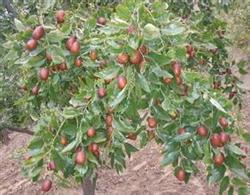Cultivation techniques of Taiwan jujube

Taiwan green jujube is bred from Indian jujube after many years of improvement. It has large fruit (general fruit weight 60g to 100g), fine core, crisp meat, sweet taste and high nutritional value; and it is planted in the same year and can enter the high yield period in the second year. Taiwan green jujube is coarse and fast-growing, has strong adaptability to temperature, and can withstand a high temperature of 35 degrees and a low temperature of-10 degrees. It is suitable for planting in tropical and subtropical regions. The high-yield cultivation techniques and measures are introduced as follows. 1. Taiwan green jujube has strong adaptability and can be planted in Taiwan, Fujian, Guangdong, Guangxi, Hainan and other provinces, but in areas with high latitude and early cold air. Measures such as promoting early flowering, early fruiting and bagging fruit should be adopted to improve yield and quality. Taiwan green jujube is not strict on soil, and can be planted in sandy soil, loam, sandy soil and slightly acidic soil, but it has higher requirements for water source, sunshine and fertilizer, so it is appropriate to choose paddy fields, terraced fields and sloping fields with sufficient light and convenient drainage and irrigation. when planting in places with drought, water shortage, thin barren, poor light and many typhoons, the quality and yield will be greatly affected. 2. Variety selection at present, the main varieties cultivated in Taiwan green jujube are: Gaolang No. 1 (also known as Fifty or Hongyun), five thousand, Biyun, Huangguan, Wuguan, Teelong, Century Jujube, and so on. There are great differences in yield, fruit shape, quality and flavor among different varieties. For example, the yellow crown variety has the largest fruit shape, the single fruit weighs 150 grams, which is similar to an apple, but the sugar content is lower, only 11 degrees, the taste is lighter and the meat quality is loose; the Hongyun variety weighs about 50 grams per fruit, egg shape, sugar content up to 14 degrees, good quality and flavor, and high price. Five thousand varieties is the most popular variety among many varieties, the fruit is oval, the single fruit weighs 80 to 100 grams, the ripe fruit is light green, the sugar content reaches 13 to 15 degrees, the flesh is white, crisp, sweet and fragrant. The price of commodity fruit is the highest. There should not be too many varieties in each orchard to choose 1 or 2 fine varieties, but 2% pollination trees should be planted to increase the fruit setting rate. Third, reasonable close planting, timely planting Taiwan green jujube growth rate is very fast, planting density should not be too large, generally planting 20-30 plants per mu. The planting density is higher and the early yield is higher. After 4-5 years, if the crown is too large and cover each other, appropriate thinning can be carried out. Hole planting, hole length and width of 80 cm, depth of about 60 cm, apply sufficient basic fertilizer, open shallow ditches, in order to drainage. It is most ideal for Taiwan green jujube to be planted from March to May. During this period, the temperature is not very high, there are more Rain Water, and the air is humid. Even if roots and seedlings are planted, the survival rate is as high as 95%, and the growth rate is also very fast. It began to blossom in August, and the fruit began to mature in November. Properly managed, the fruit yield per plant can reach about 10 kg in that year, which can achieve the purpose of planting, putting into production and income in the same year. If it is a bagged seedling, it can be planted all year round, and the survival rate can generally reach more than 95%. Even if the high-quality bagged seedlings are planted from July to August, they can blossom and bear fruit in the same year. Roots and seedlings are planted in the summer high temperature season, if the roots and seedlings are not well packed and transported for a long time, the survival rate can not be guaranteed. Fourth, fertilization technology Taiwan green jujube has fast growth, many fruits, high yield and large amount of fertilizer, such as insufficient fertilizer, it is difficult to achieve the effect of high yield and high quality. 1. The proportion of base fertilizer applied to Taiwan green jujube is relatively large, accounting for about 50% of the annual fertilizer application. When the base fertilizer of newly planted fruit trees is applied in burrowing, 10-15 kg of rotten livestock manure, 1 kg of bran fertilizer and 0.5 kg of phosphate fertilizer are applied in each hole. All kinds of base fertilizer should be mixed with soil fertilizer and then backfilled with organic fertilizer, and then the topsoil should be filled back, which is about 20 cm above the ground to prevent water accumulation on rainy days. Biennial trees should be fully fertilized within 15 days after fruit harvest and pruning. Fertilizer amount: about 20 kg of mature manure, 1.5 kg of bran fertilizer, 1 kg of phosphate fertilizer, digging ring trenches around the crown, but at a certain distance from the head of the tree, the amount of fruit will increase with the age of the tree, and the amount of base fertilizer will be increased appropriately. 2. The root system of topdressing Taiwan green jujube is developed, and most of the roots are distributed in shallow soil layer. Topdressing is generally carried out in three times: the first time is applied after shoot shooting (usually from April to May), mainly to promote the growth of new shoots, 0.1 kg compound fertilizer plus 0.05 kg urea per tree at one year's age, 0.2 kg compound fertilizer and 0.1 kg urea per tree at the age of two years. After that, the amount of topdressing should be increased appropriately with the increase of tree age. When topdressing, the fertilizer can be spread evenly in the canopy and then covered with a thin layer of soil. The second topdressing was carried out after the first flowering (July to August). The amount of topdressing was different with different tree age, and the overall amount of fertilizer application was the same as that of the first time. The third topdressing is usually in November, and the first batch of flower-bearing fruits are applied after ripening, in order to promote the fruit expansion in the middle and later stage, and the amount of fertilizer application is about 30% higher than that of the first topdressing. 3. Extra-root topdressing (foliar fertilizer) was sprayed with 0.2% potassium dihydrogen phosphate plus 0.2% urea every 15 days from the first flowering to the fruit drop period (about July to October), and was sprayed 3 times for 4 times. In addition, borax, magnesium sulfate and other trace element fertilizers should be sprayed regularly to prevent leaf yellowing and other trace element deficiency caused by lack of trace elements. Trace element fertilizer is usually applied once or twice a month. 10-15 days before fruit harvest, 0.2% potassium dihydrogen phosphate plus 0.5% glucose solution can also be sprayed once to increase the sugar content of the fruit. 5. Water management Taiwan green jujube needs a lot of water. It is necessary to keep the soil moist at the early flowering stage to facilitate the growth of branches. From 20 days of flowering to young fruit period (July to September), the water requirement should be relatively reduced, the surface soil should keep a certain degree of dryness, the pit and ditch should be kept moist, not irrigation, in order to facilitate flower bud differentiation and fruit setting. Wait for the fruit to grow to the size of the finger, to often keep the soil moist, this period of sudden drying and moisture is very easy to cause a large number of fruit drop, we should pay special attention to. The orchard should not accumulate water for a long time, but several shallow ditches can be opened in the middle of the orchard to drain water. 6. Pruning and pruning Taiwan green jujube branches are mainly lateral oblique, with large crown area and many branches. Reasonable pruning can form a good tree type, facilitate ventilation and daylighting, reduce diseases and insect pests, and improve yield and quality. 1. Pruning the trunk of the annual young tree, cut at 30 cm above the graft interface of the trunk to induce the growth of lateral branches, then select 3 or 4 lateral branches (primary branches) with sturdy growth position and good growth position as the main branches, and cut off all the other excessive branches. For trees more than two years old, the trunk is renewed (other varieties can also be grafted by cutting) after the fruit is harvested (other varieties can also be grafted), cut off at 20 cm above the main grafting interface, and leave a proper place after the new shoots grow out. A sturdy side branch or two side branches in the opposite direction are used as the new trunk, and the rest of the shoot buds are all cut off. When the trunk grows to about 50 cm, the tail is cut off to promote the growth of primary branches. According to the age of the tree, the trunk can retain 3-5 first-class branches. It is necessary to promote the early flowering and ripening of Taiwan green jujube, and keep the higher old trunk during the whole drying. After the fruit is harvested, 1 or 2 old trunks or branches are selected as the new trunk, and the height of the new trunk is about 1 to 1.5 meters. When the primary branch of the trunk grows to 50 cm, the tail tip is cut off to promote the growth of secondary branches. The rest of the good main branches can be sawed off or girdled at the base, leaving them dead, leaving a height of 1 to 1.5 meters high for new branches. This method can advance the florescence and harvest time by 1-2 months, which is especially suitable for areas where cold air comes early. two。 Too many pruning branches, unreasonable branch position, not conducive to daylighting and ventilation, not convenient for field operation, fruit quality and yield are also affected. Therefore, it is necessary to prune the branches reasonably. Shoot pruning usually begins in June and ends after all fruits are set in November, cutting off cross branches, overdense branches, overgrown branches, erect branches, slender branches, disease and insect branches, and branches close to the ground. In November, if the fruit is already quite many, the young fruit or flower ear at the end of the branch can be cut off so as not to have too many flowers and fruits and affect the expansion of the fruit. 7. The tip of Taiwan green jujube is long and brittle, and the tip is often broken because of too much fruit, so it is necessary to build a frame to support the fruit branch. The height of the scaffolding is generally 80cm to 180cm, depending on the age of the tree and the height of the main pole. The width of the scaffolding generally accounts for 80% / 90% of the crown. In order to simplify the work and save the cost, the old branches can also be used as partial supports for more than two-year-old fruit trees. Methods see the above trunk pruning part. Prevention and control of diseases, pests and weeds Taiwan green jujube has fewer diseases and insect pests, such as powdery mildew, shell insects, caterpillars, fruit flies and so on. When the climate is dry, powdery mildew is easy to occur and spreads quickly, and it does great harm to young fruits and leaves, so it can be controlled by fungicides such as strychnine, and spray once in the whole garden at the initial stage of the disease, and then once every 7 days for a total of 2 times. Shell insects can be killed by quick culling, omethoate and methotrexate, while caterpillars and fruit flies can be sprayed with trichlorfon and pyrethroid. The spraying should be stopped 10 days before the fruit ripens. Spraying time is best in the morning or evening. Taiwan green jujube has shallow roots, so it is best not to use herbicides, but to use artificial weeding. 9. Fruit thinning and fruit protection Taiwan green jujube has many flowers and fruits, and a single inflorescence can produce 4-5 small fruits. Under normal circumstances, some young fruits can fall off automatically, but after natural fruit drop, the fruit setting is still too much, so manual fruit thinning is needed. Fruit thinning should be carried out in the young fruit stage, first combined with pruning, cut off the slender branches, long branches and near-ground branches that bear too much fruit, and then remove the over-dense fruit, fine fruit and yellow-diseased fruit, leaving no more than 2 fruits per inflorescence, but one fruit per inflorescence is better. The stout branches may leave more fruit, and the young twigs should leave less fruit. In November, if the branches bear too much fruit, the flower ears and young fruits at the end of the branches can be cut off. In order to reduce the damage of diseases and insect pests and mechanical damage, manual bagging can be carried out when the fruit grows to the size of the finger. A plastic bag with a specification of 10 cm × 15 cm or 8 cm × 15 cm can be used. The bottom of the bag is pierced with a small hole the size of soybeans to facilitate ventilation and drainage. After wrapping the fruit, tighten the mouth of the bag and nail it with a stapler. Bagged fruits gain about 10% more weight than those without bagging, have a smooth skin, have no insect population, and can prevent freezing damage to the fruit when the temperature drops suddenly, but there are more florists, and the sugar content of the fruit will decrease slightly. Whether bagging or not depends on different circumstances. The pericarp of Taiwan green jujube changes from turquoise to light green or yellowish green when it is ripe, with a full appearance and a shiny skin. The fruits should be harvested in time when they are ripe. If they want to be transported over a long distance, they can be harvested at well-done. If the meat is overcooked, the meat will become softer, the quality and flavor will become worse, the price is also low, and it is not resistant to storage and transportation. Be careful when harvesting, so as to avoid damage and affect the value of the goods.
- Prev

Technology of scientific harvest, storage and preservation of fresh jujube
Fresh jujube has been widely cultivated in rural areas all over the country, and its fruit is bright red in appearance, crisp and sweet in taste, and rich in a variety of nutrients. The content of vitamin C in fresh jujube is 60-80 times that of apple and 30 times that of citrus. Scientific storage and preservation of oysters can greatly reduce the loss of growers and increase production and efficiency. Ensure that there are fresh dates in the market for a long time.
- Next

Promoting High Yield of Jujube Tree by Proper Fertilization
Only scientific and rational fertilization of jujube trees can strengthen tree vigor, improve pest resistance, improve quality and increase yield. Fertilization of jujube tree is divided into basal fertilizer and topdressing. The scientific application period of base fertilizer is from the mature period of jujube fruit to the soil thawing in the following year, and the topdressing is divided into three stages: the early stage of bud, the early stage of full flower and the rapid expansion period of fruit.
Related
- Moge, come on! The staff of the peasant association in the producing area of cantaloupe were frightened when the crowd gathered.
- Causes and Solutions of low Fruit setting rate of Apple
- Symptoms and control measures of passion fruit virus disease
- Fruit growing lesson: how do apple orchards keep high yields?
- Can you build orchards in the mountains? What are the pros and cons?
- How to manage the coloring period of Crisson grape?
- This paper introduces the processing technology of two kinds of fig products.
- How much is a month for retired teachers in rural areas by 2020?
- How can strawberry planting increase sugar content? We should pay attention to management in many aspects.
- What are the cultivation techniques on how to improve the yield of golden fruit?

